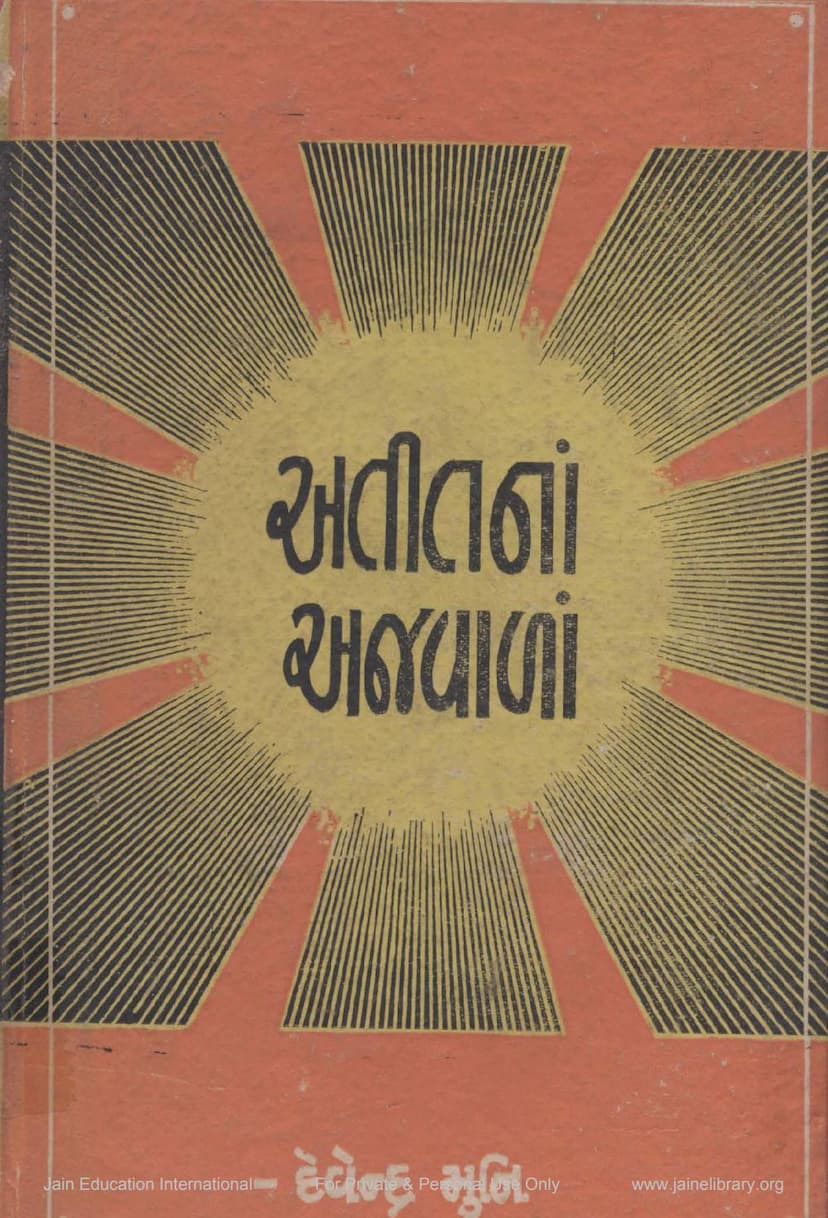Atit Na Ajwala
Added to library: September 1, 2025

Summary
Here's a comprehensive summary of the Jain text "Atit na Ajwala" by Devendramuni, based on the provided catalog link and text snippets:
Book Title: Atit na Ajwala (અતીતનાં અજવાળાં) - which translates to "Lights of the Past" or "Gleams of the Past."
Author: Shri Devendramuni Shastri (શ્રી દેવેન્દ્ર મુનિ શાસ્ત્રી)
Publisher: Shri Lakshmi Pustak Bhandar, Gandhi Marg, Ahmedabad (શ્રી લક્ષમી પુસ્તક ભંડાર, ગાંધીમાર્ગ, અમદાવાદ)
Publication Year: First Edition 1975
Overview:
"Atit na Ajwala" is a collection of inspiring stories and biographical sketches of notable figures from Jain history and potentially broader Indian history, highlighting their virtues, wisdom, and significant life events. The author, Devendramuni Shastri, states in the preface that the book does not present a chronological history but rather introduces "luminous stars of history" who have deeply influenced him. The overarching theme is to draw inspiration from these historical personalities and their exemplary lives.
Key Themes and Content:
The book aims to provide readers with moral and spiritual guidance through the lives of individuals who demonstrated exceptional qualities. These stories often emphasize:
- Virtues: The text focuses on individuals who embodied virtues such as compassion, forgiveness, steadfastness, wisdom, integrity, righteousness, and detachment.
- Inspiration and Guidance: The author hopes that by reading these stories, individuals will gain inspiration and guidance for their own lives, helping them navigate challenges and strive for spiritual growth.
- Overcoming Adversity: Many of the narratives likely showcase how these historical figures faced and overcame difficulties through their strength of character and adherence to principles.
- Spiritual and Moral Values: The core of the book lies in showcasing the importance of spiritual values and ethical conduct in personal and public life.
Notable Figures and Stories (based on chapter titles and snippets):
The table of contents (Page 7) provides a glimpse into the diverse individuals and themes covered in the book. Some prominent examples include:
- Mahamantri Shaktal (મહામંત્રી શકટાલ): A story highlighting his wisdom, foresight, and integrity, particularly in dealing with a deceitful scholar named Vararuchi. The narrative showcases Shaktal's cleverness in exposing Vararuchi's falsehoods and his dedication to upholding truth and justice.
- Acharya Shri Hirvijay Suri (આચાર્ય શ્રી હીરવિજયજી): A story likely detailing his interactions with Emperor Akbar, showcasing his profound knowledge, spiritual prowess, and ability to influence even powerful rulers towards righteousness and compassion (e.g., advocating for the cessation of animal sacrifice).
- Siddhasen Diwakar (સિદ્ધસેન દિવાકર): This section probably recounts his intellectual debates, his conversion to Jainism, and his profound understanding of philosophy and spiritual truths.
- Ratnakarsuri (રત્નાકર સૂરિ): A story likely depicting his struggle with worldly attachments and his eventual renunciation, highlighting the challenges faced by even great spiritual leaders.
- Nihsprha Sant Anandghan (નિઃસ્પૃહ સંત આનંદઘન): Narratives focusing on his detachment from worldly possessions and desires, demonstrating the power of true renunciation.
- Daanveer Jagdushah (દાનવીર જગડુશાહ): A story of immense generosity and charity during a severe famine, emphasizing his compassion and selfless service to the community.
- Mahamamtri Udayan (મહામંત્રી ઉદયન): This likely details his rise to prominence through honesty and integrity, possibly highlighting his pivotal role in the history of Gujarat.
- Raja Kumarpal (રાજા કુમારપાળ): Stories focusing on his compassion and his adherence to Jain principles, potentially including his famous decree regarding the protection of animals.
- Sankalpani Drudhata (સંકલ્પની દૃઢતા) - Steadfastness of Resolve: A theme likely exemplified by a historical figure who achieved great things through unwavering determination.
- Acharya Haribhadra (આચાર્ય હરિભદ્ર): Likely covers his intellectual prowess, his debates with other religious schools, and his profound contributions to Jain philosophy.
Author's Intention (from the preface):
Devendramuni Shastri expresses his natural inclination towards reading historical, philosophical, cultural, and spiritual texts. He meticulously notes down points that impress him. He clarifies that "Atit na Ajwala" is not a book of connected history but an introduction to "shining stars of history" who have had a profound impact on him. He acknowledges the vastness of the universe and the fleeting nature of human life, but highlights how certain rare individuals leave an indelible mark on the human heart. He hopes the book will inspire readers. He also expresses gratitude to his guru, Shri Pushkarmuniji Maharaj, for his blessings and support in his literary endeavors. He also thanks Shri Dhanrajbhai Kothari for his interest in the translation and publication of the book.
Overall Significance:
"Atit na Ajwala" serves as a repository of inspirational anecdotes from Jain tradition, offering readers valuable lessons in ethics, spirituality, and the pursuit of a meaningful life. By recounting the deeds and virtues of these historical figures, the book aims to illuminate the path towards self-improvement and spiritual enlightenment.